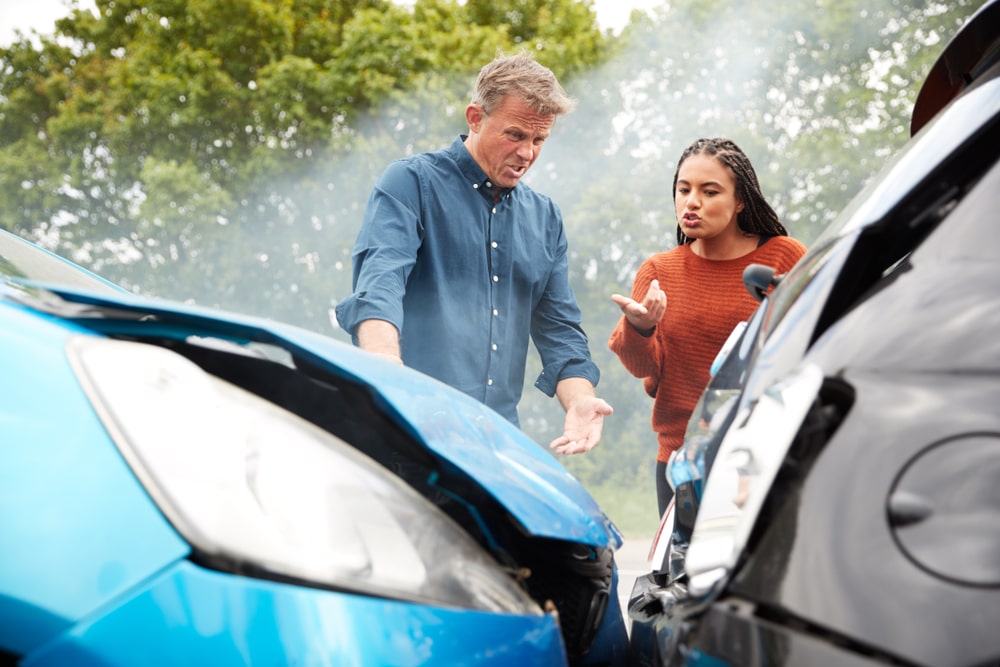
28 Feb Is California A No-Fault State?
Besides the immediate medical assistance, you will also have to think about auto insurance after meeting with an accident in California. But before you get auto insurance in the state, you could be wondering is California a no-fault state?
The simple and direct answer to this question is no. Like the majority of states in the US, California is NOT a no-fault state for the purpose of auto insurance. Whenever there is a road accident in California, whether it’s on the highways or within city limits, one of the two drivers will be held responsible for it. In reality, both drivers may have to share some degree of responsibility for the accident.
A view of a no-fault state in detail
There are twelve no-fault states in the US. In these states, drivers involved in a motor vehicle accident are responsible to pay for their own medical expenses, irrespective of who caused the collision. In most of these states, drivers are required to cover their medical expenses by using personal injury protection (PIP).
In addition, drivers in no-fault states do not enjoy the right to sue the other for damages, other than in cases specified by the state. Drivers’ expenses and injuries will have to exceed a certain threshold for them to be able to sue the other party for damages sustained in the accident. Whichever driver is at fault as per the state’s negligence laws will be held responsible for the damages.
The following features should give you a clear view of what exactly a no-fault state means:
1. Medical expenses
Each driver involved in the accident uses their insurance to cover their own medical expenses.
2. Insurance
Drivers use their PIP insurance, which replaces the compensation that would have been received from the driver at fault. In no-fault states, drivers get their insurance claims quickly because no fault of any party needs to be determined first.
3. Premiums
The premium amount paid by drivers in no-fault states is higher than that paid by in-fault or tort states. That’s probably because the fraud rate is higher in no-fault states. The higher rates of fraud, coupled with compulsory PIP insurance, increase costs for car insurers, which ultimately get passed on to consumers.
4. Number of states:
The Insurance Information Institute considers twelve states as no-fault states. These are Florida, Kansas, Hawaii, Massachusetts, Kentucky, Minnesota, Pennsylvania, Michigan, New Jersey, North Dakota, New York, and Utah.

What are the types of no-fault auto insurance?
You should know that there are three types of no-fault insurance. These are pure no-fault, choice no-fault, and add-on no-fault. Let’s get to know them here:
1. Pure No-Fault
It’s a mandate for holders of pure no-fault auto insurance to have personal injury protection (PIP). Moreover, they can sue the driver at fault only if they sustain severe injuries or incur high financial losses due to the accident. This type of no-fault auto insurance is used in nine out of twelve states.
2. Choice No-Fault
Holders of a choice no-fault auto insurance policy will have to have PIP. However, they may choose to opt out of the system that limits lawsuits. This type of no-fault auto insurance is used in three out of twelve states.
3. Add-on
PIP is either mandatory or optional for policyholders. Moreover, there are no restrictions on lawsuits. This type of no-fault auto insurance is common in eight states as well as in the District of Columbia. However, it’s important to note that the Insurance Information Institute does not consider these states as true no-fault states. That’s because they do not restrict or limit a driver’s right to file a lawsuit seeking additional compensation.
Pros and cons of no-fault auto insurance
The benefits of no-fault auto insurance are that it lets drivers have their claims for damages paid out quickly after accidents. The insurance also reduces minor personal injury lawsuits. If no-fault insurance is absent, then drivers might have to wait for long to get their medical bills reimbursed, especially when the fault isn’t immediately determined.
Another benefit of no-fault auto insurance is that insurers don’t have to spend as much money on lawsuits and can pass on the money saved to customers. Insurers can get a wide range of coverage besides medical expenses, including household services and child care.
However, there are also some cons of no-fault insurance. Policyholders have a limited ability to sue drivers at fault. This can make it difficult to get compensation for damages. Also, not-at-fault drivers may still see increasing rates after filing PIP or medical expenses claims.
How does auto insurance work in a fault state like California?
We know now that the answer is no if you ask “Is California a no-fault state?” But you should delve deeper than this in reality. The Insurance Information Institute considers California to be a fault state, also known as a tort state. In this state, the driver at fault is held financially responsible for the damage sustained by the other in the accident. The person is held responsible not only for the car accident but also for the resulting losses, such as property damage and medical expenses.
In California, it’s compulsory for all drivers to buy auto insurance. As a matter of fact, driving a car in California without insurance is unlawful and can lead to fines for anyone found to be driving a motor vehicle without insurance. When buying auto insurance, you should understand the details of your coverage—something that many drivers do not pay heed to until they are involved in an accident.
Generally, auto insurance plans in California are required to meet a minimum policy called the 15-30-5 rule. As per this rule, the insurer has to pay up to:
- USD $15,000 for the injury or death of one individual
- USD $30,000 for the injury or death of more than one individual
- Minimum USD $5,000 as coverage for property damage
Whenever drivers are involved in a motor vehicle accident in California, both are required to show their proof of insurance. In case the police come to the accident site, both drivers will have to produce their proof of insurance. Additionally, during the exchange of information, each driver will provide certain documentation with the individuals involved, including their license, contact information, and proof of insurance.
Common Causes of Motor Vehicle Accidents in California
It’s common to see the roads of California being clogged with traffic. The significant commercial nature of the state often causes people to be constantly on the go, leaving no time to slow down in life. As such, it should not come as a surprise that California surpasses many other states in the country when it comes to motor vehicle accidents.
Generally, in case of motor vehicle accidents in California, the police look for the engagement of the driver in any of the following:
- Driving Under the Influence (DUI)
- Angry or aggressive driving
- Distracted driving
- Other reasons for driver negligence can include:
- Violation of traffic laws
- Poor road conditions
- Defective vehicle parts
The finding of the police office is not always necessary to determine the cause of the accident. Since California is a fault state, several cases of motor vehicle accidents can take complicated turns, especially when more than two drivers are involved. .
What’s Pure Comparative Negligence in California?
You will have to prove liability if you wish to collect compensation for damages sustained during a motor vehicle accident. But that does not mean that the other person bears 100 percent of the responsibility. California has a pure comparative negligence model to handle personal injury claims. Under this model, you can claim compensation for injuries and damages even when you are 50 percent at fault for the accident.
But the amount you get will be slashed by your percentage of fault. Take, for instance, if you are at 20 percent fault, then you will get only 80 percent for damages as compensation. Similarly, a 75-percent fault of yours will give you 25 percent for damages.
How to prove liability for recovering damages?
A motor vehicle accident lawyer can assist you in gathering evidence to strengthen your insurance claim and increase your chances of damage recovery. Here are some ways in which you can substantiate your case:
- Proof of financial responsibility: Law in the state of California makes it a mandate for drivers to have sufficient accident coverage. If you are in an accident, your car accident attorney in Oroville can review the relevant insurance policies and recommend the best way to claim compensation.
- Police report: A written police report may be vital to your case, but it may not always be enough to acquit you of any fault for the accident. You will have to talk to your attorney to collect additional evidence to substantiate your case.
- Evidence collection: Photos, video footage, or testimony from eyewitnesses can serve as evidence that can help you strengthen your case.
- Recovery of compensation: Whether it is claiming compensation from your insurance company, or from the other party, a professional accident attorney can help you maximize damage recovery.
Most claims for damages due to motor vehicle accidents involve negligence of some kind. To prove negligence, you must prove the following:
- The driver of the other vehicle owed you a duty of care,
- The other driver violated the duty of care, and
- You have sustained injuries and damages due to the violation
At the same time, you should be aware that auto insurance companies are profit-driven companies. Therefore, they are always looking for chances to deny claims as a means to cut their costs. The following are some instances when an auto insurance company may deny your claim:
- If there’s evidence that suggests that you had injuries from before,
- If there is a factual dispute about who caused the accident, or
- If there is a disagreement between the parties about the extent of damages.
Let’s not forget that the insurance company of the other driver will have its own way of determining fault in a motor vehicle accident. They may have their own investigators on the scene to reconstruct the entire accident. You can expect them to see you in court if they find that their driver wasn’t at fault, even though there’s evidence that suggests otherwise.
Can you claim auto insurance compensation if you are partly at fault?
Is California a no-fault state? No, it’s not. But you can still claim for damages even if you are partly at fault in a motor vehicle accident in the state. However, the amount will be less than what you would get if you are completely faultless. Investigators of auto insurance companies assign partial fault in motor vehicle accidents that involve three or more vehicles. But recovering a significant sum as compensation for damages can be challenging, given the processes followed by the insurance companies.
In accident cases where both drivers are at fault, the percentage of negligence of both drivers is determined by the court. The court ultimately determines which percentage of damage each driver has caused by considering the actions that have led to the accidental injuries.

What you should do while getting auto insurance in California?
Driving on California’s highways can be a risky proposition because of the high rates of motor vehicle accidents. Whether it’s a minor bump or a major collision, you should know what you can do so that you don’t land up committing blunders.
When buying auto insurance, you should review the application carefully before signing. You should determine if your policy includes all the desired coverages, deductibles and limits. After you buy your policy, make sure you check the declaration page, where you will find essential information pertaining to covered drivers. You will also get to know about the vehicles insured, the coverage limits amounts, as well as deductibles. Ensuring the accuracy of this information is extremely important.
If In Doubt, Contact The Steve Gimblin Personal Injury & Car Accident Lawyer For Any Questions
So, if you are getting auto insurance in a state like California, you should familiarize yourself with all the nitty-gritty of your policy. Doing so will help you understand it and tackle the situation better when the need to claim arises. Always read your auto insurance policy document thoroughly to be crystal-clear about all coverages and exclusions.
If you or a loved one is the victim of an accident including negligence, contact us today for a complimentary consultation.


No Comments